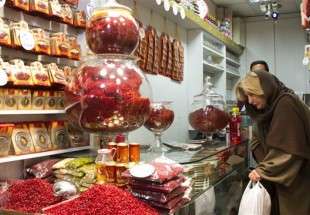The UAE and Spain are the prime suspects, reportedly importing what is globally known as “red gold” from Iran and rebranding it for exports at much higher prices.
“The UAE imports 50 tonnes of Iranian saffron annually, but it is interesting that export statistics show 100 tonnes of saffron leaving the country a year,” Farhad Saharkhiz, a member of the presiding board of Iran’s Saffron Exports Development Fund said.
“Spain also imports 70 tonnes of saffron from Iran, but figures for its exports are quoted at 130 tonnes. This means they are selling something like a mixture of edible colors and saffron roots to the world in the name of the Iranian saffron,” he added.
Traditional cultivation and harvest methods, as well as bulk sales, stand out as the drawbacks of the sector but middlemen and speculators are an additional burden.

Each gram of premium Iranian saffron can retail for $65. By comparison, a gram of gold at current rates is no more than $42. However, for Iranian producers, it barely pays for the labor.
Saffron cultivation and harvest is a painstaking process which requires 200,000 strands of crimson crocus blooms to be gingerly picked in the morning to make one kilo for sale.

Iran produces over 90% of the world’s saffron, with the northeastern Khorasan province being the capital of the spice. However, the country’s share of the $1.5 billion business is less than $250 million.
Much of the crop produced by villagers are bought at knockdown prices by local arbiters who themselves sell it to foreign buyers in large stocks. This means the bulk of the added-value accrues to foreign intermediaries, while the genuine produce barely reaches the end consumer.
Saffron cultivation has a history of more than 3,000 years in Iran, where the reddish, aromatic substance is used to flavor food and pastries, with further application in medicine and cosmetics.

Iranian lawmaker Farhad Falahati was quoted as saying earlier this month that processing saffron into value-added products was the missing link. He also said a French drugmaker had used Iran’s saffron to produce antidepressants and herbal medicine.
According to Saharkhiz, Iran’s saffron received the three-star superior taste award of the International Taste & Quality Institute (iTQi) based in Belgium in 2017, among 2,000 food and drink products.
New rival
Iran has recently found a bitter rival for production of saffron in neighboring Afghanistan. Saharkhiz said the smuggling of saffron bulbs had become a new problem for Iran which has long been suffering from illegal drugs produced in Afghanistan.
“Saffron bulbs are considered among Iran’s genetic resources, which we should be sensitive to their exit. But unfortunately, when we tell the relevant authorities that they are being smuggled into Afghanistan in truckloads after truckloads, they nonchalantly say that 'saffron cultivation is better than poppy cultivation',” he said.

Saharkhiz said Dutch producers had started cultivating saffron in Afghanistan’s virgin lands.
“They want to eliminate Iran from the saffron market and replace it with Afghanistan. Even worse, some Afghan businessmen come to Iran, buy our saffron and sell it to the world in the name of high-quality Afghan saffron,” he said.
/SR













